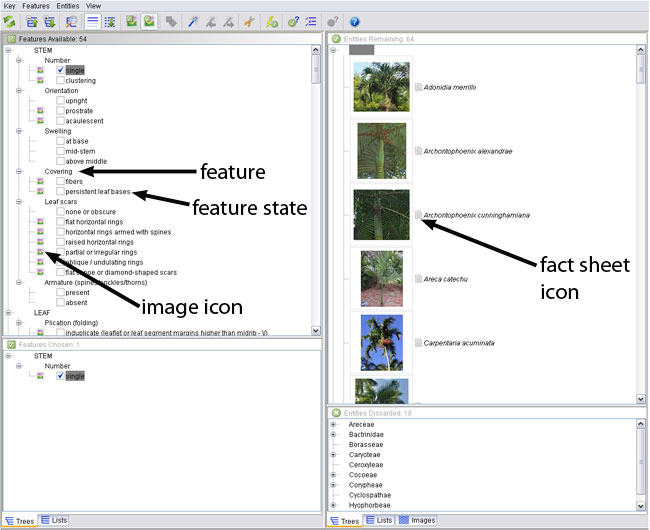How to use the key
This tool offers a Javascript-based interactive matrix key built using Lucid3 software. Lucid3 is software for creating and using interactive identification keys. Lucid is developed by Identic in Brisbane, Australia. Visit the Lucidcentral website for more information on Lucid and Lucid3.
Any modern web browser can be used, such as Internet Explorer, Firefox, Chrome, or Safari. Javascript must be enabled.
An interactive matrix-key is quite different from a traditional dichotomous key. The user is recommended to consult Lucid Best Practices on occasion to pick up new tips and tricks for using the interactive key.
Web pages such as fact sheets attached to items in Lucid3 keys may be considered pop-ups by certain browsers (such as Internet Explorer) when clicked on. If your browser blocks these pop-ups, you should allow pop-ups for this Lucid tool in your browser's Internet settings.
Screen window
A Lucid key has four panels.
- The upper left window Features Available lists the identification features and feature states to choose from.
- The upper right window Entities Remaining lists the available taxa.
- The lower left window Features Chosen lists which feature states are currently selected.
- The lower right window Entities Discarded lists the taxa that have been discarded based the features that have been selected.
Features available
In order to simplify use of the key, the features for this key are organized by plant part in the Features Available panel. This way, if a user is trying to identify their palm using a partial specimen, they can quickly and easily find features that apply.
Navigating the key
Feature and entity trees can be expanded by clicking the “+” next to the grouping feature or entity. Feature states are selected by clicking once in the checkbox next to the state name. Clicking the state a second time deselects the state. As feature states are selected, the entities that do not have those features will be moved into the Entities Discarded panel.

You may choose features in any order. Usually, you will want to choose the characters you can most easily address first. Feel free to skip around among the features to use the ones for which you have material available. If you are looking at a tall palm in the landscape, you might want to concentrate on features of the stem. If you have received a single leafleaf:
in palms -- the leaf blade (which is usually divided into leaflets or leaf segments), the petiole (or leaf stalk) and the sheath (which forms the attachment of the leaf to the stem)
or leafleaf:
in palms -- the leaf blade (which is usually divided into leaflets or leaf segments), the petiole (or leaf stalk) and the sheath (which forms the attachment of the leaf to the stem)
part for identification, you’ll want to use the features of the leafleaf:
in palms -- the leaf blade (which is usually divided into leaflets or leaf segments), the petiole (or leaf stalk) and the sheath (which forms the attachment of the leaf to the stem)
. If you cannot determine whether the palm has pinnatepinnate:
like a feather; palms with pinnate leaves usually have compound leaflets attached to a rachis, although a pinnate leaf may be entire with pinnate veins (e.g., <em>Chamaedorea metallica</em>)
or palmatepalmate:
like the palm of a hand; fan palms have palmate leaves that are usually divided into leaf segments arising from a central point, although a fan palm may have entire leaves (e.g., <em>Licuala grandis</em>)
leaves, you will find few features available. You might want to browse the factsheets, rather than working with the key, when plant material is extremely limited.
You might find that after choosing a few features, the list of species is small enough to lead to an identification. If one palm is left in the Entities Remaining panel, be sure to verify the identity by reviewing the fact sheets and checking other sources. Many palms are similar, and you might have a palm that is not included in this key. If several palms remain after you have exhausted the features you have available, you might be able to use the fact sheets to determine the genus. Several genera represented here form hybrids, and so the species cannot be identified using this tool. If no species remain, you may have made a mistake. Reconsider any features you think might be questionable.
All entities and some feature states are illustrated with photographs. Clicking on the image thumbnail (or image icon if thumbnails are not displayed) brings up a larger size image and gives the user access to the full image gallery for the feature state or entity, if available. All entities are linked to HTML pages containing fact sheets for the entity. Clicking the small grey page icon next to the entity thumbnail will open the fact sheet in a new browser window.
A glossary with links from the fact sheets is provided to assist the user in understanding palm morphology terminology used in the key and fact sheets. Various diagrams of palm morphology are also included on the morphology page. These images may also be viewed from anywhere in the tool by using the Morphology drop down menu and selecting the desired diagram.
Multiple states of a feature may be selected. For instance, if a ripe fruit appears reddish orange, you can choose both red and orange for that feature. If unsure of the correct state, it is often better to try a different feature before selecting a state you are unsure about. For more hints on navigating the key, see the Best Practices page.


